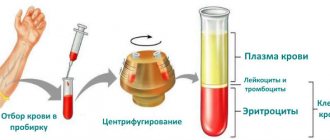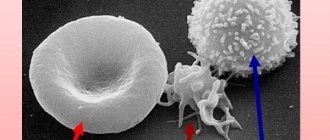- Causes of blood in urine in women
- How to determine what caused the appearance of blood in the urine?
- Cystitis
- Urethritis
- Endometriosis of the urinary system
- Hematuria in pregnant women
- Blood in urine due to genitourinary tract infections
- Functional hematuria
- Blood in urine: diagnosis
A condition in which the number of red blood cells in the urine exceeds the physiological norm is called hematuria. Normally, there are no blood impurities in the urine, and microscopy of the sediment can reveal single unchanged red blood cells that enter there from the area of the external genitalia after a thorough toilet. However, it often happens that blood is detected in a clinical urine test. This condition in 60% of cases signals the development of urological pathology affecting the kidneys, bladder or urinary tract. However, in 40% of cases, hematuria is a consequence of gynecological diseases or blood diseases accompanied by hypercoagulation.
If a small amount of blood is found in the urine, which can only be detected using laboratory techniques, we are talking about microhematuria. At the same time, the color of urine remains within the physiological norm.
If the patient’s urine changes color, becomes cloudy and indicates the presence of a significant amount of blood in it, gross hematuria is diagnosed.
Causes of blood in urine in women
- Cystitis.
- Urethritis.
- Endometriosis of the urinary system (urinary tract or bladder).
- Idiopathic hematuria of pregnancy.
- Injury or severe bruise of the kidney.
- Urolithiasis (formation of kidney stones).
- Tumors and polyps of the bladder.
- Urogenital infections.
- Traumatic injuries to the urethra after catheterization or cystoscopy.
- Taking anticoagulants.
However, sometimes panic about the appearance of blood in the urine turns out to be false. Thus, some medications and foods can give urine a red color.
How to determine what caused the appearance of blood in the urine?
In the case when the blood is completely dissolved in the urine, the problem should be looked for in the kidneys. In order to accurately establish the localization of the pathological process, the patient is prescribed a three-glass urine sample.
Renal bleeding, or nephrorrhagia, is a pathological condition in which the urine turns red or brown and contains clots. It can be caused by certain poisons, blood diseases, infectious pathologies, as well as kidney injuries.
If the appearance of blood in the urine is accompanied by severe pain, this may indicate the presence of a stone or tumor in the urinary system. It should be noted that in this case the urine takes on a bright scarlet color.
The appearance of blood at the end of urination indicates that it is in the bladder.
A condition in which blood leaves the urethra outside the process of urination indicates injury to the walls of the urethra.
Frequent urge to urinate, which does not bring complete relief due to the fact that the bladder cannot completely empty, accompanied by the appearance of blood in the urine, signals its inflammation.
With glomerulonephritis, urine becomes dark brown or the color of meat slop. This disease is accompanied by edema, oliguria and increased blood pressure. In the case when joint pain is added to the above symptoms, lupus erythematosus is diagnosed.
https://youtu.be/D9YAIL4iVtU
Causes and symptoms
Before prescribing special tests and making a final diagnosis, the doctor must assume a certain disease in a person. How he does it? Almost every disease has its own specific symptoms that make it possible to suspect it. Since there are a large number of causes of blood in the urine, it is quite difficult to distinguish between them.
Only a qualified doctor can make a diagnosis correctly and as quickly as possible. But almost everyone can roughly navigate their pathology in order to contact the right specialist. To make this task easier, the following information will help, which describes the most common causes of impurities and their most characteristic symptoms.
| Group of reasons | Examples of pathologies | Typical symptoms |
| Urinary tract infections |
|
|
| Injuries |
Bladder ruptures, as a rule, do not lead to bleeding. The first symptom of this condition is a complete absence of urination. |
|
| Urolithiasis (UCD) |
| The quiet presence of a stone inside an organ (kidney/bladder) in most cases does not manifest itself in any way and proceeds without pain. It is quite difficult to confuse renal colic with any other condition:
|
| Autoimmune diseases |
| In most cases, these pathologies are asymptomatic or with minor manifestations. In addition to blood impurities in the urine after a long course of the disease, the following may develop:
|
| Tumors |
| |
| Coagulation disorders |
|
|
| Rare specific infections | Despite the exotic names, these diseases exist in the Russian Federation and people regularly fall ill with them. Unfortunately, diagnosis often takes a long time, which leads to negative consequences. Therefore, it is important to remember the following infections:
| What should alert the patient and think about the presence of these infections? 1. Ineffectiveness of conventional treatment for the development of ARVI (persistence or progression of symptoms for 1.5 weeks); 2. Presence of signs of damage to other organs (kidneys, liver, spleen, etc.); 3. The appearance of hemorrhages on the skin or mucous membranes of the mouth, eyes, nose. |
If blood in the urine, pain and other symptoms do not allow one to draw an unambiguous conclusion about the existing disease, the doctor will prescribe a number of additional tests. They will allow you to narrow the diagnostic search and correctly determine the cause of the pathology.
Causes of mucus and blood in urine
The causes of mucus and blood in the urine do not necessarily signal a pathological process developing in the body. If this is an isolated phenomenon and occurs in women during their next menstrual period, do not panic. Insufficient hygiene of the genital organs before taking the test also leads to the appearance of mucus in the urine, some amount of which may normally be present in urine.
Prolonged retention of urination also increases the amount of mucus. Most often, pathological impurities detected in urine are the reason for further diagnostic search, since many diseases lead to the following symptoms:
| Kidney damage |
|
| Pathologies of the ureters | ascending infection |
| Bladder diseases | acute cystitis (see cystitis in women: symptoms, treatment) |
| Urethral infection | acute urethritis |
| Other diseases | STIs (chlamydia, ureaplasmosis, mycoplasmosis) |
Often people mistake purulent impurities for mucus. In laboratory conditions, it is very easy to differentiate these phenomena: mucus is a collection of epithelial cells, and pus is a collection of leukocyte cells. Diseases, the manifestations of which are blood in the urine mixed with pus, are always serious and should not be left to chance:
| Kidney diseases |
|
| Ureteral diseases | ascending infection |
| Bladder diseases | acute cystitis (see cystitis in men: symptoms, treatment) |
| Urethral diseases | acute urethritis |
| Other diseases |
|
Causes of blood in urine in men
Blood in the urine in men, in addition to general diseases characteristic of both sexes, may indicate specific pathologies, such as:
- BPH;
- prostate cancer (see prostate cancer: symptoms, treatment);
- prostate abscess.
Prostate adenoma and abscess can also manifest as impurities of pus and mucus, alone or in combination with a bloody component. It is worth noting that 20% of people over 40 years of age who go to the doctor with hematuria are diagnosed with prostate cancer, so this symptom definitely requires immediate examination by doctors.
The causes of blood in the urine in men are not always associated with the disease. Sometimes a similar symptom is observed in men after active sexual intercourse, especially with the use of homemade urethral irritants. The urethra has a thin and easily damaged inner lining, so any mechanical impact easily leads to injury. The initial consequences of such actions are hematuria, and then an infection easily clings to the damaged mucosa and urethritis develops.
It is men who are more likely to experience hematuria due to heavy physical exertion. In this case, the mucous membrane of the bladder walls is damaged when they come into contact with each other and leads to the release of red blood cells into the urine. The second reason is an increase in blood pressure due to stress, leading to an increase in the load on the kidneys and disruption of filtration processes. In this case, the symptom is one-time in nature and does not bother the patient.
Causes of blood in urine in women
The structure of the urinary tract differs significantly among representatives of different sexes. In girls, the anatomical features of the urethra facilitate the penetration and spread of various infections. Since this organ is much shorter than that of men, and it lacks physiological bends, microorganisms can quite easily get through it into the bladder and even the kidneys. That is why, when blood appears in the urine of women, it is necessary to first exclude the following diseases:
- Acute pyelonephritis;
- Cystitis;
- Urethritis.
Also, representatives of the fair sex need to remember the specific reasons for the appearance of blood impurities. One of these reasons may be endometriosis of the bladder or ureters - this is a disease in which cells from the lining of the uterus begin to spread throughout the body. They can get into almost any tissue: the peritoneum, conjunctiva of the eyes, navel, intestines and others.
During hormonal changes (including during the natural course of the cycle), these “dropout centers” can increase in size, bleed and damage healthy organs. If the urinary system is damaged, this can lead to blood in the urine, pain and difficulty urinating:
- passing a small amount of urine;
- feeling of “incomplete emptying”;
- the need to frequently go to the toilet;
- the appearance of a nighttime urge to urinate.
Women are also characterized by benign hematuria, which is often observed during pregnancy. There is no explanation for this phenomenon yet - it is assumed that the enlargement of the uterus leads to compression of the organs of the genitourinary tract and their microtraumatization.
Causes of blood in the urine of a child
For children, as well as for women, the most common cause of hematuria is infections - acute pyelonephritis and cystitis. Why is this happening? In Russia, a very common problem is congenital anomalies of the urinary tract. These include prolapse of the kidney (nephroptosis), incorrect position of the ureters, the presence of their curvatures, and others. Every year, these pathologies are registered in more than 50 thousand children.
By themselves, these defects do not lead to the development of the disease, but they provoke stagnation in the urinary organs. The lack of sufficient passage is a stimulus for the growth and reproduction of harmful bacteria. With timely diagnosis and proper treatment of blood in the urine, these conditions do not pose a danger to the child. The main thing in their development is to assess the presence and severity of the anomaly. In some cases, surgery may be required to correct it and prevent relapse of the disease.
Another pathology specific to childhood is hereditary nephropathy (nephritis). This disease is much less common - approximately one child per 5,000 people, but such a problem exists in the Russian Federation. It is often detected during preventive examinations, since apart from changes in tests, the disease does not manifest itself in any way at an early stage. With it, the following violations in the OAM are observed:
- The appearance of blood cells;
- Presence of protein or casts;
- The presence of leukocytes (inflammatory cells) in the absence of traces of bacteria/fungi.
In some children, this pathology is accompanied by hearing loss and visual impairment. In this case, the disease is called “Allport syndrome”. If left untreated, young patients quickly develop kidney failure, cardiac dysfunction and significantly reduced life expectancy.
Cystitis
Cystitis is the most common cause of blood in the urine in women. This disease, which is an inflammation of the bladder, can occur in acute and chronic forms. In this case, frequent, sometimes false urges to urinate occur, blood appears in the urine, and patients also complain of constant or periodic pain in the lower abdomen.
Cystitis can develop due to local hypothermia, in the presence of inflammatory processes in the vagina, due to non-compliance with personal hygiene rules, and due to venereological, gynecological or urological pathologies. Also, signs of cystitis may appear after deflowering (defloration). At the same time, the pathological process can be a consequence of frequent colds, weakened immunity, constant stress and dietary errors.
Urethritis
This is another very common cause of blood in the urine. This disease develops due to inflammation of the walls of the urethra. In this case, patients complain of sharp pain when urinating, scanty mucopurulent discharge appears from the urethra, and blood impurities are found in all portions of urine.
The development of a pathological process in women can be triggered by urethral stricture (narrowing of the lumen of the urethra), urolithiasis and injury to the urethral walls during medical procedures.
Endometriosis of the urinary system
Endometriosis of the urinary system is a secondary pathology. Initially, the disease affects the uterus, then the appendages, and less often the external genitalia and vaginal vault. Most often, endometriosis affects the bladder (up to 90% of cases), less often the urinary tract (1-2%).
With the development of the pathological process, a tumor-like formation is formed in the wall of the bladder, which is morphologically similar to the endometrial tissues that are shed monthly by the uterus during menstruation. In this case, during menstruation, a woman experiences pain in the bladder area and the process of urination is disrupted. As a result, hematuria may develop.
If endometriosis is localized in the urinary tract, compression of the ureters occurs, the outflow of urine is disrupted, intrapelvic pressure increases and cyclic hematuria develops.
Why is urine red?
According to doctors, red urine is a common phenomenon that can indicate either a symptom of pathology or be a variant of the norm. Changes in the color of urine often occur as a result of eating certain foods. This phenomenon does not require intervention and disappears on its own after 1-2 days.
Long-term staining of urine, accompanied by painful sensations, indicates a pathology of the urinary system. The red color of urine is given by the erythrocytes (red blood cells) that appear in it. This phenomenon in medicine is referred to as hematuria. Depending on whether traces of blood are visible to the naked eye, two types of hematuria are distinguished:
- Macrohematuria
- when the urine turns red. - Microhematuria
- the presence of blood cells is detected only as a result of laboratory tests.
Hematuria in pregnant women
Normally, pregnant women do not have blood in their urine. However, sometimes a pathological process can develop, and at any stage of gestation. Unfortunately, to this day science does not know the exact causes of idiopathic hematuria in pregnant women. In the early stages, according to experts, blood in the urine may appear due to changes in hormonal levels, and later due to increased intra-abdominal pressure, impaired blood supply to the renal pelvis and mechanical compression of the excretory system by the growing fetus.
I would like to emphasize that this is a rather dangerous condition that can lead to very serious consequences. Firstly, due to developing fetal hypoxia, placental insufficiency may occur, which often causes premature termination of pregnancy, weakening of labor and premature birth. Secondly, in the postpartum period, a woman may develop coagulopathic and hypotonic uterine bleeding.
Children born to mothers who suffered from hematuria during pregnancy adapt much worse to extrauterine life than babies born to healthy mothers.
Urine blood test
In order to identify problems of the urinary system in time, you should donate urine for OAM prophylactically. The study determines many parameters, including the presence of red blood cells.
There are two methods for determining blood urine:
- use of test strips;
- OAM.
For OAM, urine is collected at home and then sent to a laboratory technician. In laboratory conditions, urine is examined under a microscope, visually counting the number of red blood cells in three fields of view. Using the Nechiporenko test, red blood cells, leukocytes, and casts are counted. The difference between the method is that it is used to count the exact number of cells in the biomaterial.
How to independently detect signs of blood in urine
At home, using test strips, a person can independently detect hematuria if it is not visually detected. This is a method that uses disposable paper strips that change color depending on the amount of red blood cells and hemoglobin in the fluid.
This method is suitable for people who have been diagnosed with a disease that forms hidden traces of blood residue in urine. With treatment, a person will be able to control the appearance of blood cells. If they increase, you should immediately contact a urologist.
Important! Test strips only indicate the presence of red blood cells and hemoglobin, but do not show their exact amount. To do this you need to pass the OAM.
Why is it important to properly prepare for a urine test?
Incorrect collection of biomaterial leads to a change in the result. The doctor will make an incorrect diagnosis, miss the disease, and prescribe the wrong treatment. Therefore, you must adhere to the following rules:
- before the analysis, the patient must adhere to a diet (do not eat fried, fatty, salty, spicy, do not drink alcohol);
- do not smoke on the day of the study;
- do not take medications 3 days before testing (especially for blood thinning medications), if this is impossible due to health reasons, tell the attending physician and laboratory assistant about the drug used;
- before urinating, wash the external genitalia with bactericidal soap (this will neutralize foreign microorganisms that are located outside);
- morning urine is submitted for analysis immediately after sleep (for OAM, all urine is collected, for the Nechiporenko test only the middle portion, that is, the person first urinates in the toilet, then inside the container, then pees in the toilet again);
- to collect fluid from adults, use a sterile container (you cannot collect urine in a home jar, it contains foreign microorganisms);
- to collect fluid from small children, a urinal is used, which is attached around the external genitalia with Velcro (after urination, it is detached and the fluid is poured into a plastic container);
- the biological material is sent to the laboratory assistant immediately after its collection in the morning; if this is not possible, the container is placed in the refrigerator for no more than 2 hours);
- women who are menstruating should not undergo OAM (at this time, blood discharge from the uterus appears and small blood clots come out in the urine);
- Before urinating, women need to cover the vaginal opening with a tampon (it may contain red blood cells remaining after menstruation);
- OAM cannot be performed immediately after instrumental studies (cystoscopy, radiography); a general analysis is carried out before or 14 days after them.
Norms for the content of red blood cells in the urine of adults
In adult women and men, the number of red blood cells in urine is the same. It should not exceed two cells in the field of view of the microscope.
In pregnant women, the amount of most blood and urine parameters changes. The number of red blood cells in urine should not exceed 5 cells. A slight increase may be caused by fetal compression of the mother's internal organs.
Norms for children
Normal values in children depend on their age. The younger the child, the more red blood cells are normally produced.
In newborns, the normal value is no more than 7 cells. In children under one year old, the number does not exceed 5 units. From one year to 7 years - 3-4 cells. With age, the indicator equalizes to the number of red blood cells in adults and is 0-2.
Norms for older people
In people over 50 years of age, the body ages and illnesses worsen. Therefore, the number of red blood cells increases slightly. The norm of red blood cells in healthy elderly people is 3-4 cells. If the urine contains blood, the indicator increases and the disease develops. It is necessary to urgently go to the doctor, find out where the blood is coming from and begin treatment to get rid of the disease.
Blood in urine due to genitourinary tract infections
With the development of an infectious process in the genitourinary system, the source of bleeding, as a rule, becomes the mouth of the ureters and capillaries that penetrate the inflamed and swollen walls of the renal pelvis. In this case, patients may develop both microhematuria and macrohematuria. During laboratory diagnostics, infectious pathogens are detected in the urine, triggering the development of the inflammatory process. After the inflammation is eliminated, the flow of blood into the urine stops.
Functional hematuria
This is a condition in which blood appears in the urine after heavy physical activity, overheating or hypothermia. As a rule, it is combined with albuminuria (the appearance of protein in the urine). At the same time, temporary hematuria, which develops during toxic infections (influenza, bronchopneumonia, rubella, infectious mononucleosis, mumps, tonsillitis, sepsis, etc.), is functional in nature.
Methods for detecting hematuria
The following methods can be used to detect a reaction to blood in the urine:
- Organoleptic, when a visual assessment of the color of urine is used. Since this indicator can change under the influence of various foods and drugs, this method needs more careful testing.
- The use of an express test is based on the interaction of a special reagent with blood hemoglobin. To obtain information about the presence of blood in a urine test, special test strips soaked in a reagent are used. However, this method can also give an incorrect (false-positive) result, which needs to be clarified in the traditional way (examination under a microscope).
To establish why the reaction to blood in urine tests is positive, many diagnostic methods are used, both traditional and using the latest achievements of scientific and technological progress. In addition to interviewing and examining the patient, general and bacterial examination of urine, as well as cytology analysis, computed tomography, ultrasound, and urography are used.
Blood in urine: diagnosis
In the event that blood is found in a woman’s urine, she must undergo an instrumental and physical examination and be prescribed a general urinalysis with sediment microscopy. At the same time, studies are prescribed to identify possible infections or tumors. If necessary, cystoscopy of the bladder and urethra and intravenous urography are performed. Tomography of the kidneys and pelvic area and ultrasound examination of the urogenital organs may also be prescribed.
Diagnostics
A symptom can be a sign of a serious illness, even oncology, so a man is recommended to undergo a thorough examination to determine the cause of the problem. Diagnostics may include:
- medical history examination, examination by an andrologist;
- laboratory tests of blood, urine;
- instrumental examination.
A man may be prescribed:
- a general urine test, which helps identify red blood cells, minerals that can cause stones, bacteria that lead to the development of an infectious disease;
- study of coagulation and platelet hemostasis - to determine the rheological properties of blood;
- urine analysis according to Nechiporenko, the purpose of which is to identify inflammation in the urinary system, counting red blood cells in 1 ml of urine;
- Kakovsky-Addis test - consists of counting red blood cells in the collection of urine excreted over 1 day;
- bacteriological culture - to identify possible pathogens of the infectious and inflammatory process of the urinary system;
- clinical blood test - will help indicate anemia, signs of inflammation;
- determination of GFR, blood creatine - indicators of kidney activity.
To clarify the source of bleeding (renal hematuria or from the urinary tract), a three-glass test is prescribed. The procedure involves collecting urine in portions sequentially into 3 containers. A man needs to collect the initial, middle and last portion of discharge during one urination.
If maximum coloring is observed in the first container, then most often this is a sign of injury or disease of the urethra. If the color intensity is greater in the third container, then this is typical for inflammation of the bladder neck, posterior urethra. Intense color in the middle portion may indicate inflammation of the prostate gland and urethra. If the color has approximately the same intensity in all three containers, then the symptom often indicates inflammation of the bladder, kidneys, polyps of the bladder or urethra, oncology, or kidney stones.
If clots are present, then the source of bleeding can be determined by their shape: large ones that do not have a specific shape form in the bladder, small oblong ones - in the ureters.
Instrumental diagnostic methods for hematuria syndrome are:
- Ultrasound of the kidneys. Allows you to identify changes in size, shape, location, kidneys, bladder, ureter.
- X-ray of the kidneys. The image reflects the structure and topography of the urinary organs.
- Cystoscopy. Allows you to visualize the state of the internal surface of the MP.
- Angiography. Using a contrast agent, it helps to evaluate the functioning of blood vessels and blood flow characteristics.
- Radioisotope renography. Gives an idea of the state of the urinary tract, helps to assess the state of tubular secretion and glomerular filtration.
- Kidney biopsy. Examination of kidney tissue helps identify signs of inflammation, tumors, scarring, infection, and the quality of blood circulation around the organ.








